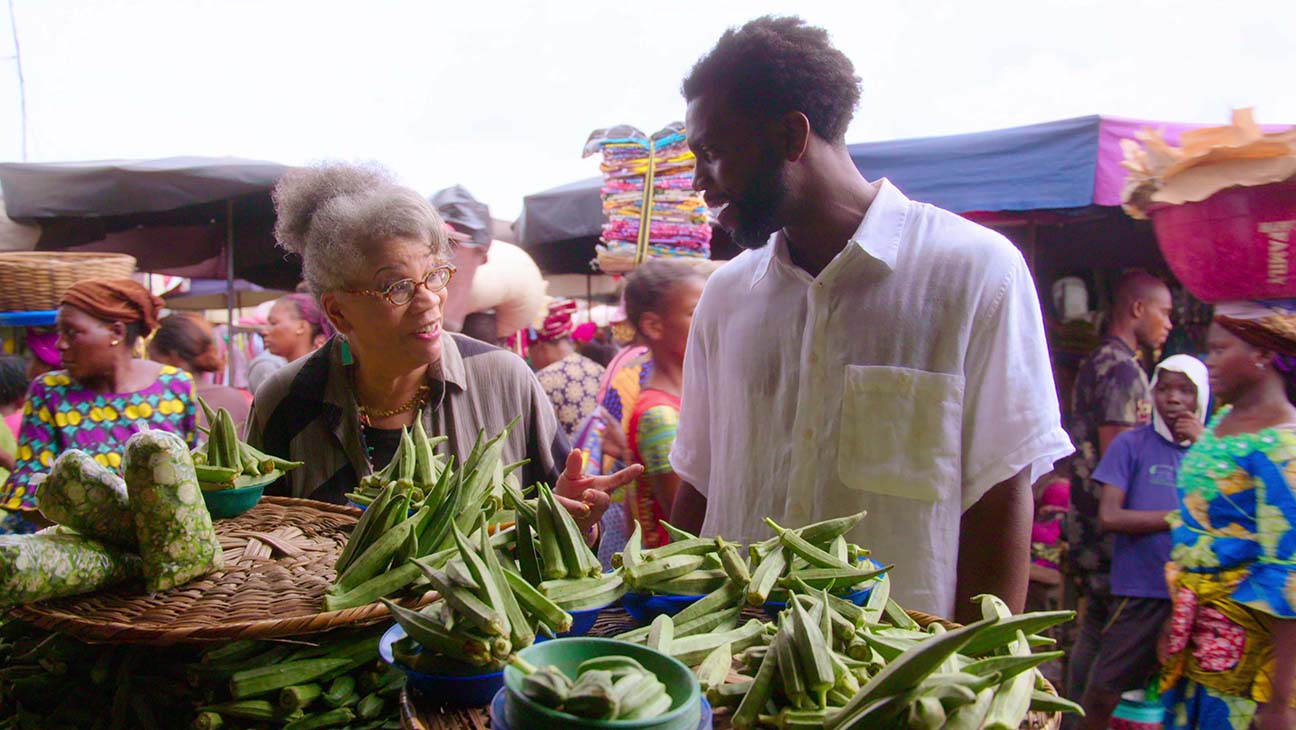(Akiit.com) It’s a revelation. The rich history of Black heritage cooking and how it has influenced American cuisine is on view in this enlightening, heartfelt and surprisingly well-crafted documentary. The host for this four-part Netflix epicurean travelogue is Stephen Satterfield, founder of Whetstone Magazine, which is dedicated to food origins and culture. He starts his culinary journey in western Africa and continues to the U.S., making his deeply personal sojourn a voyage of self-discovery for everyone.
In Episode I, Satterfield gets an illuminating tour of Benin, by Dr. Jessica B. Harris, author of High on the Hog: A Culinary Journey from Africa to America, whose book is the source material for the docuseries. Her deep, shaman-like voice is reminiscent of Maya Angelou’s and makes you feel like you are in the presence of an oracle. Harris: “Food is how we know who we are and how we are connected.” She and other guides, chefs (Valérie Vinakpon) and preservationists recall how African people were rounded up, enslaved, brought to boats in port towns like Benin’s Ouidah and vetted. The captives were shipped out and their food traditions came with them on their harrowing transatlantic passages to the western hemisphere. Learning that okra, yams, black-eyed peas, fava beans and rice are staples there and here is fascinating. Discovering the history of the four-kilometer slave trail that ran from the center of Ouidah to the sea and a mass grave (Cemetery of Slaves), is so sobering it devastates Satterfield and will have the same effect on audiences.

Episode 2 takes the proceedings to Charleston, South Carolina, where other emissaries chart the history of Black cuisine, with particularly profound insights from Michael W. Twitty, author of the food blog Afroculinaria and book The Cooking Gene: A journey Through African American Culinary History in the Old South. “Cooking puts you in the presence of our ancestors,” notes Twitty. He and others expound on the essential elements of Black cuisine that influenced American food, from Carolina Golden Rice to using all parts of the pig (aka high on the hog). A very deep preservation of African life has been maintained on South Carolina’s isolated Sea Islands as manifested in Gullah Geechee culture. Viewers also learn that enslaved chefs established the palette for a new democracy, and elders to this day teach the next generations how to cook, thus preserving traditions.
Episode 3 spotlights two of the most lauded epicureans of the 18th and 19th centuries, Hercules Posey, head chef for Pres. George Washington and James Hemings, for Thomas Jefferson. The latter, brother of Sally Hemings, was the first American chef to train in France and is credited for bringing French fries and mac and cheese to America. Their careers, families and fights for freedom are known. Specific menus and portraits are non-existent. The Los Angeles’ restaurant Hatchet Hall keeps their form of hearth cooking alive serving history-influenced dishes like Hemings Snow Eggs (soft custard with basil, peach, toasted almond). Equally intriguing are the stories of Thomas Downing, the entrepreneurial Oyster King of New York City, and the smart businessman Albert E. Dutrieuille who created a catering empire/dynasty in Philly.
Episode 4 brings the series to a conclusion as the production ventures to Texas, highlighting the significance of the holiday Juneteenth. Satterfield is briefed on the history by James Beard finalist Jerrelle Guy, author of Black Girl Baking, who unveils some of her prized desserts (Raw raspberry-hibiscus cheesecake) and their historic significance. Meeting Black cowboys (Northeastern Trail Riders Association) and seeing how African Americans influenced cowboy culture—from cuisine to rodeo events—is also very informative. Add in clips of tantalizing cowboy stew, beef brisket, baby back pork ribs and tamarind paste broth and the intersection of culture and food continues to amaze. It’s like taking a graduate course in four self-contained episodes.
Technically, the entire production team should take a deep bow. The rich colors, eye-catching patterns, and vibrant restaurant scenes are in part courtesy of production designer Kati Davenport. Engaging camera angles, overhead shots and intimate portrait-like closeups from cinematographer Jerry Henry (I Promise Africa) never fail to mesmerize. All segments have a natural rhythm because editor Ephraim Kirkwood (Wu-Tang Clan: Of Mics and Men) cut the footage with a certain precision while string music and other sounds caress the proceedings due to composer/musician John Zarcone. The overall excellence of the entire series is courtesy of directors Roger Ross Williams (The Apollo), Jonathan Classberry and Yoruba Richen. Conversations, dialogue and a detailed blueprint are thanks to writers Classberry, Shoshana Guy (Dateline NBC) and Christina Lenis (Gun Trucks of Vietnam).
If ever there was a culinary series deserving of an Emmy, this is it. Its indelible images, emotionally peaked encounters and wealth of history and knowledge are extraordinary. Black America’s legacy lives on because people guard the gates of our culture. The makers of this brilliant miniseries and the guides who take us on this journey are those guardians.
Trailer:
Currently on Netflix.
Columnist; Dwight Brown
Official website; http://DwightBrownInk.com









Leave a Reply